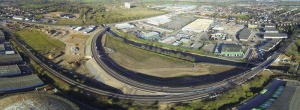Rail minister visits new £59m Ipswich rail link

Transport minister Stephen Hammond was in Ipswich on Friday 21 March to see the newly completed 1.2km stretch of railway built by Network Rail to increase capacity for freight trains and ease a major bottleneck affecting passenger services on the Great Eastern Main Line.
The £59m Ipswich chord – which includes four new bridges, two new embankments, a 413m retaining wall and 1.2km of new track and signalling equipment – has been built on the site of the former Harris bacon factory to the north of Ipswich station and goods yard.
From April, the new link will remove the need for freight trains travelling to and from the Port of Felixstowe to use the sidings adjacent to Ipswich station as a turning point, eliminating a major bottleneck on the busy Great Eastern main line and freeing up capacity for both passenger and freight services. The improved layout will also mean improved punctuality and performance on the Anglia route.
The region’s roads will also benefit from this vital infrastructure investment; by 2030, the increased rail capacity provided by the new link will have helped remove at least 750,000 lorry journeys from the A14 each year, improving road safety and reducing both traffic congestion and carbon emissions.
Accompanying the minister on his visit were Ipswich MP Ben Gummer, Cllr Graham Newman of Suffolk County Council, Network Rail and other local representatives.
ADVERTISEMENT
Rail Minister Stephen Hammond said: “We are investing record amounts into transforming our railways because we recognise they are a key engine for growth. It is great to see that investment taking shape on the ground through projects like the Ipswich Chord. This will deliver a real boost to the freight industry, driving forward our economy and freeing up capacity to improve passenger services. In addition, it will help remove lorries from our roads, delivering safer journeys, a cleaner environment and relieving congestion.”
Ben Gummer MP said: “This little stretch of railway will have a huge impact on rail capacity in our region – increasing freight travel from Felixstowe and freeing space on the Ipswich to London main line. I was proud to have helped secure the money for this to go ahead and thrilled to be able to thank Network Rail and everyone else who has worked hard to bring the project in on time and on budget.”
Councillor Graham Newman, Suffolk County Council’s cabinet member for roads and transport, said:
“This is, hopefully, one of many initiatives to improve the vital Felixstowe to Nuneaton rail corridor. This will ensure our national infrastructure can continue to carry ever greater numbers of containers by rail, thus relieving the congested A14. It will also help to maintain the dominant position of the Port of Felixstowe as Britain’s foremost container port, the success of which is responsible for more than one in every ten jobs in Suffolk.”
Richard Schofield, Network Rail route managing director, said: “The completion of the new rail link is great news for passengers and road users in Ipswich and across the Anglia region. It’s a fantastic example of how investment in infrastructure can deliver benefits for local and regional economies and will contribute to the growth rail freight while helping passenger services improve further.
“I’d like to thank local residents and businesses for their patience during the construction of this new stretch of railway and look forward to continue to work with them and the local authority in the future. This is an exciting time for the railway in Anglia as we look to deliver more infrastructure projects of this size to continue to improve passenger and freight services.
“A big thank you also goes to our partners at Spencer Rail Limited, who worked tirelessly and with great professionalism to deliver this project on our behalf.”
Network Rail worked closely with contractors Spencer Rail Limited to deliver:
• Four new bridges
• 2,400 metres of new track
• 12 new signals installed
• 413 metre long, 4 metre high retaining wall built
• 100,000 tonnes of earth removed
• Two new embankments
• Improvements to the existing overhead line equipment

